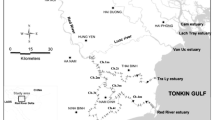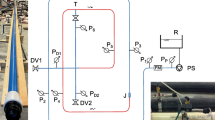Abstract
For wastewater discharged into one branch of a narrow estuary, the resulting maximum concentration or temperature can vary markedly depending upon the proximity of the discharge site to the branching and upon how the rate of discharge is adjusted. Explicit formulae are derived for the optimal discharge rate to minimize the maximum concentration or temperature experienced in the estuary, while disposing of a given total wasteload over a tidal period. Graphs are used to show the approximately factors of two reductions in that minimized maximum concentration or temperature when the second branch is large, the discharge close to the branching, the decay rate large or the mean river flow large. By optimizing with respect to one pollutant, there is a reasonably wide range of other pollutants for which the environmental impact is nearly minimized.
Similar content being viewed by others
References
T. Webb and R.B. Tomlinson, Design procedures for effluent discharge to estuaries during ebb tide. J. Env. Eng. ASCE 118 (1992) 338-362.
R. Smith, Optimum use of holding tanks to avoid pollution surges in narrow estuaries. IMA J. Appl. Math. 51 (1993) 187-499.
R.T. Giles, Optimal strategies for discharging pollutants into narrow estuaries. Water Research 29 (1995) 563-569.
J.H. Bikangaga and V. Nassehi, Application of computer modelling techniques to the determination of optimum effluent discharge policies in tidal water systems. Water Research 29 (1995) 2367-2375.
R. Smith and A Purnama, Two outfalls in an estuary: Optimal wasteload allocation. J. Eng. Math. 35 (1999) 273-283.
A. Kay, Advection-diffusion in reversing and oscillating flows: 1. The effect of a single reversal. IMA J. Appl. Math. 45 (1990) 115-1437.
E.R. Holley Difference modelling of stream pollution. J. Sanit. Eng. ASCE 100 (1969) 968-972.
W.H. Li and M.E. Kozlowski, DO-sag in oscillatory flow. J. Env. Eng. ASCE 100 (1974) 837-854.
G.J. Macdonald, and R.N. Weisman, Oxygen-sag in a tidal river. J. Env. Eng. ASCE 103 (1977) 473-488.
D.J. O'Connor, Estuarine distribution of nonconservative substances. J. Sanit. Eng. ASCE 91 (1965) 23-42.
J.B. Schijf and J.C. Schonfeld, Theoretical considerations on the motion of salt and fresh water. Proc. Minn. Int. Hydraul. Conference, Minneapolis, Minn. (1953) 321-333.
J.M. Gaudet and A.G. Roij, Effect of bed morphology on flow mixing length at river confluences. Nature 373 (1995) 138-139.
A. Kay, Advection-diffusion in reversing and oscillating flows: 2. Flows with multiple reversals. IMA J. Appl. Math. 58 (1990) 185-210.
Author information
Authors and Affiliations
Rights and permissions
About this article
Cite this article
Smith, R. Optimal discharging in a branched estuary. Journal of Engineering Mathematics 38, 309–322 (2000). https://doi.org/10.1023/A:1004747216103
Issue Date:
DOI: https://doi.org/10.1023/A:1004747216103




